The human face of climate change are climate-induced migrants. Their fate diverges. Environmentally induced movement can take place within a country, or lead people to move across international borders. Sometimes it can only be for a season, sometimes it is for the long term. At times these population movements, triggered by environmental factors, can be forced as well as a matter of choice. The only certainty is that climate-induced migration disrupts the lives of the people affected.
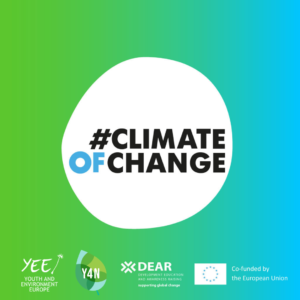
#ClimateOfChange is a pan-European campaign to build a better future for climate-induced migrants, the human face of climate change. The campaign centres on four key pillars:
- Develop an evidence-based narrative on climate change impacts as one key driver for migration, highlighting the interconnection to our current development model, economic system and our way of life.
- Make young people aware of their role and responsibility on human-induced climate change root causes and its consequences in terms of forced displacement and irregular migration.
- A focused strategic, participatory and innovative pan-European communication campaign carried out in the whole EU and particularly in 23 member states including Southern and Eastern Europe.
- Actively involving youth in advocacy actions calling for a more sustainable model including climate change mitigation measures and specific protection schemes for climate migrants.
WeWorld – Italy is the project leader of this campaign, coordinating the work of 15 partnering organisations and 10 associate organisations. Youth Environment Europe as a member of the European Environmental Bureau plays role among the partner youth associations to multiply the impact of the campaign, and empower young people to learn more on the nexus between migration, climate change and the current economic model.
Our common goal: End Climate Change, Start Climate of Change.
For more information on the Climate of Change campaign see wwww.climateofchange.info (to go live soon).
Project Activities
YEEinvolvement in the Climate of Change project seeks to inform, inspire, empower young people through 2 distinct parts.
- Climate of Change Webinar Series
Starting October 23rd until the beginning of December, together with our colleagues from Youth 4 Nature, we will organise online events pertaining to topics related to climate change. The series of webinars will look at climate-induced migration from different perspectives. We will provide an introduction into the phenomena, the challenges it creates, and later on suggest a range of possible nature-based solutions. In the first webinar we will focus on the pressures of a warming climate (and the subsequent rising frequency of extreme weather events) on human mobility. How the environment and climate we live in affects our mental and physical wellbeing and health, will be at the core of our second online debate. The third webinar is dedicated to climate adaptation and the role nature-based solutions play in our actions to protect the planet and fight against climate-induced migration. The plan for the last webinar is to sum up all the ideas and wishes expressed in the previous ones and integrate them in an interactive exchange with European policy makers and shapers.
A series of short animated videos summarising ideas and thoughts discussed at the various webinars to provide future viewers with an accessible starting point into the topic.
- Cooperation with local organisations
Three local organisations are partnering with us on creating activities that highlight how climate change affects their communities. These organisations are Sáminuorra (Sweden), Organization Earth (Greece), and Green Association (Bulgaria). The projects we are setting up with them are meant to support their work, introduce them to a wider audience, but also help them raise awareness on possible (local) solutions to the problems they face.
The three projects will take place with both online and in person events. Organization Earth and Green Organization will focus specifically on the role of sustainable agriculture and sustainability in urban contexts. Sáminuorra will be introducing the topic of indigenous populations and the impact of climate change on their communities as well as empowering young Sami people.
Dates: TBC
23 October 2020
Climate Change and Migration
On the 23rd October, YEE together with the EEB co-hosted a webinar on climate migration as part of its #ClimateofChange project, a pan-European campaign to build a better future for climate-induced migrants, the human face of climate change. In case you weren’t able to make it, you can watch it here, read a summary of the event below , and if you did manage to join us and want to learn more about the topic, we have assembled some additional resources for you below!
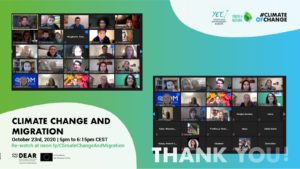
Elisha Winckel, our Liaison Officer on Climate Change led through the event – introducing the speakers and facilitating the interaction between the audience and panelists. Natalie Lupi (Climate of Change Project Coordinator) launched YEE’s #ClimateOfChange series by providing an overview of the greater campaign and emphasised the need to act on climate migration. The ensuing presentations, by representatives from academia, civil society, journalism and international governance, were structured to provide people listening in a broad overview of the topic – the controversies surrounding it, the measures being discussed and taken, and a glimpse of the experiences of the people affected by a changing climate.
Dr. Caroline Zickgraf (Co-Founder and Deputy Director of the Hugo Observatory at University of Liège) introduced the topic of climate migration and highlighted three key considerations when dealing with the subject. Firstly, what’s the right term? Climate refugees? Environmental migration? Climate and migration? The answer depends on where the focus should lie, that is the people affected or the phenomena. Using the term “human mobility” encompasses forced migration, displacement and voluntary migration. Secondly, how many people are we talking about? Naturally, knowing the numbers helps policymakers and organisations but they need to be taken with a grain of salt. A lot of the numbers out there focus on the future not the present, meaning that they only provide a glimpse of a possible scenario. Another problem are the guesstimates used to scare people into climate action. The result? Restrictive migration policies that further harm affected people. (One of the most trustful sources on current numbers is the Internal Displacement Monitoring Centre). And lastly, where do people go? Fear-mongers warn of millions and millions of people coming to Europe. The reality is far from that. Most people move within their country, and if they do move or are displaced across borders, it is usually to neighbouring countries.
Senior Expert in Migration, Environment and Climate Change at the International Organization for Migration (IOM), Mariam Traore Chazalnoel, started on an encouraging note. She clearly sees a rise in interest in human mobility in UN policy discussions, for her a way to gauge the political will to tackle the issue. Over the last years two major international developments are especially notable: the creation of a UNFCCC Taskforce on Disaster Displacement, and the Global
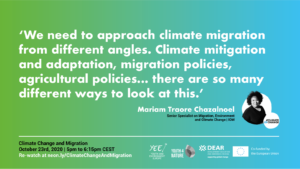 Compact for Safe, Orderly, and Regular Migration, the first international agreement setting out objectives and commitments to respect when managing migration. However, this progress has mainly been concentrated on the realm of principles, with legislations and actual practices only slowly changing. “There’s also a bigger push by young people to have a seat at the table in the policy debate”, Mariam pointed out. “For while their voices were missing”, she went on, “but their involvement can transform the narrative into one that is more hopeful and aspirational.”
Compact for Safe, Orderly, and Regular Migration, the first international agreement setting out objectives and commitments to respect when managing migration. However, this progress has mainly been concentrated on the realm of principles, with legislations and actual practices only slowly changing. “There’s also a bigger push by young people to have a seat at the table in the policy debate”, Mariam pointed out. “For while their voices were missing”, she went on, “but their involvement can transform the narrative into one that is more hopeful and aspirational.”Lucie Pélissier (Co-President of CliMates and consultant for des Ponts pas des Murs) underlined what Mariam said, “4 years ago, there was hardly any awareness on the issue”. People did not grasp the extent of the question at hand, and as emotional first-hand accounts were tough to come by, she got involved in doing a web-documentary on people in Senegal and Bangladesh displaced by a changing climate.
70.000 people are displaced by weather events in Europe every year. In the last 10 years that amounts to 700.000 stories of loss. But who were those people? Our last two speakers, Marta Rodriguez and Lillo Montalto, decided to look past the numbers and find some of the people whose lives were disrupted.
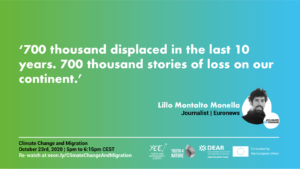 They tracked down people all across Europe, recording the stories of people who decided to stay back in ghost towns, like Ion Sandu in Cotul Mori, Moldova. Their investigation also brought them to La-Faute-Sur-Mer in France, where they talked to the Biraults who rebuilt their home after a severe flood destroyed it. Despite being able to rebuild, they feel like strangers in a new home. Marta and Lillo, also tracked down people who had to move away, like Zekira Ikanović. Despite being able to rebuild her life, she feels like a migrant away from home, even though she stayed in her own country. You can read and see all about these people and others in Euronews’ web series on Europe’s Climate Migrants.
They tracked down people all across Europe, recording the stories of people who decided to stay back in ghost towns, like Ion Sandu in Cotul Mori, Moldova. Their investigation also brought them to La-Faute-Sur-Mer in France, where they talked to the Biraults who rebuilt their home after a severe flood destroyed it. Despite being able to rebuild, they feel like strangers in a new home. Marta and Lillo, also tracked down people who had to move away, like Zekira Ikanović. Despite being able to rebuild her life, she feels like a migrant away from home, even though she stayed in her own country. You can read and see all about these people and others in Euronews’ web series on Europe’s Climate Migrants. The webinar then allowed participants to put their questions to the panel, such as how climate migration can best be addressed within international political frameworks and the implications of considering climate migration as an adaptation to climate change. The event finally concluded with closing statements from our speakers illustrating how – unsurprisingly – “solving” climate migration is very complex, but emphasising how it requires a bottom-up approach that listens to the perspectives of the people affected and acknowledges that climate migration has and always will be an issue and is not inherently problematic, although many instances and aspects of it can be.
If you want to learn more about climate-induced migration, why not start with these amazing resources?
This brief but sharp take-down of climate migration myths is a great way to introduce you to the topic and dispel misunderstanding.
This short report gives an excellently clear and informative explanation of the terminology, data, and different historical approaches.
This recent series explores many interesting aspects of the intersection between the Covid-19 pandemic and climate migration.
This page shows a whole series of recorded webinars and short videos on climate migration for a very in-depth audio-visual explanation.
Here is a podcast from a top-quality development website regarding climate migration, especially in small island developing states (SIDS) like Kiribati.
And if you’re feeling very brave, here are two landmark, high-level reports on climate migration from 2015 and 2018!
05 November 2020
Climate Change and Public Health
The event provided fascinating insight into the important intersections between the health of the planet and our own physical and mental health – in case you weren’t able to make it, you can watch it here or read the following summary.
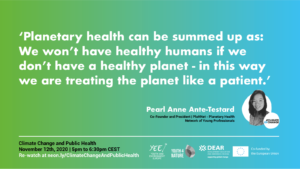 Chloé ten Brink, our Youth Advocacy Coordinator, moderated the webinar and guided participants through the discussion as our wonderful range of speakers called upon their experiences and knowledge to provide incredibly thought-provoking insight into the relations between climate change and gender, economic inequality, and mental health, among many others.
Chloé ten Brink, our Youth Advocacy Coordinator, moderated the webinar and guided participants through the discussion as our wonderful range of speakers called upon their experiences and knowledge to provide incredibly thought-provoking insight into the relations between climate change and gender, economic inequality, and mental health, among many others.Our first speaker was Vijoleta Gordeljevic, the current Health and Climate Change Coordinator at the Health and Environment Alliance (HEAL). She managed to give an incredibly clear but densely informative overview of the health impacts of climate change, pointing out that although it may not be the most obvious danger to health, its indirect effects include the increased risk of many diseases, cardiovascular failure, and malnutrition, both from subtle changes like higher temperatures and severe weather events like floods. Even in Europe, we have 790 000 excess deaths due to ambient air pollution annually! However, she also stressed that there is so much to win for public health by tackling climate change. Phasing out fossil fuels or reducing the amount of meat we consume will both reduce our GHG emissions as well as greatly improve human health.
Our second speaker was Dr Kathleen Mar, the leader of ClimAct at IASS Potsdam and a Senior Associate at Women Leaders for Planetary Health. She explained that the effects of climate change are gendered, with women and girls being disproportionately impacted. Events such as floods or droughts exacerbate women’s poverty and increase the burden of unpaid domestic and care work, which tends to mostly fall upon women. However, similarly to Vijoleta, Kathleen strove to emphasise the positive flip-side to this – although women are currently excluded from economic activity and decision-making, if we correct this then we only have incredible resources to gain in the fight against climate change. Hence, climate change solutions must also be gender-just, seeking to provide equal access and benefits to women and to alleviate or compensate their work burden.
Next up, we heard from Pearl Anne Ante-Testard, co-founder of PlaHNet and PhD Candidate at the Conservatoire National des Arts et Métiers. She began by summing up the fundamental concept of planetary health by explaining beautifully that “we won’t have healthy humans if we don’t have a healthy planet – so in this way we are treating the planet like a patient”. This holistic approach is all about realising that human health is completely dependent on the health of the natural systems around us. Planetary health involves a convergence of numerous academic fields and encourages the medical profession in particular to pro-actively look to areas like ecology in order to prepare in advance for climate-change induced health problems – as they say, prevention is better than cure!
Finally, we listened to Ruby and Christabel Reed, co-founders and co-directors of Advaya, a global platform for transformative experiences and alternative education.
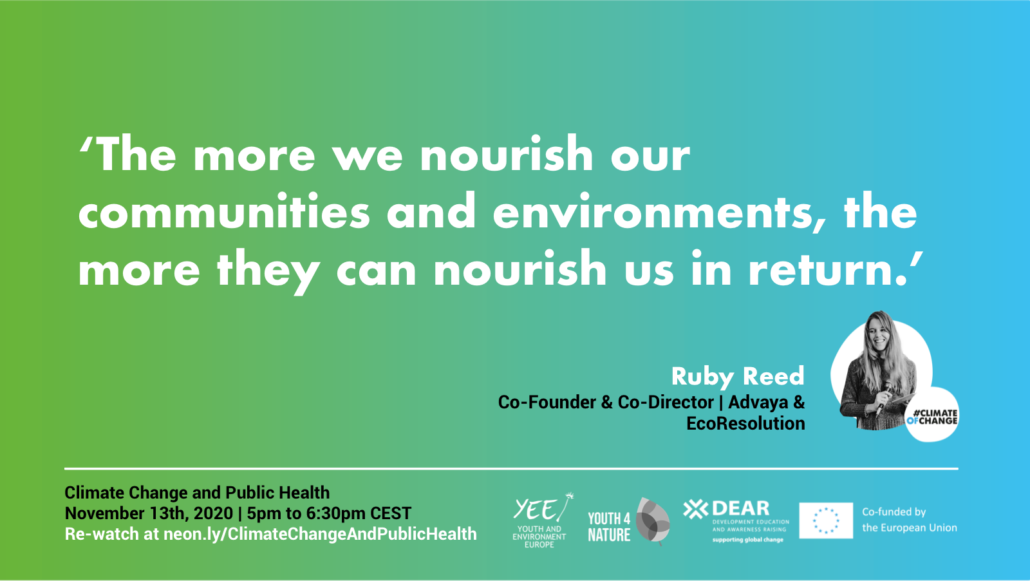
Ruby talked us through the fact that in order to combat climate change, we have to completely transform the systems of domination over the environment that are causing it in the first place. In doing so, we must return to a partnership paradigm, which centres on the fact that the more we nourish our communities and environments the more they can nourish us in return. Christabel then presented the positive points for engaging in this type of activism, from building community and eco-system well-being, to that of individuals. Among her many suggestions were participatory democracy and supporting local initiatives, as well as nine tips for improving mental health in the face of eco-anxiety, which can affect young people in particular, such as being present in nature and meditative practice.
The rest of the webinar saw our panellists responding to each other, and then questions from our many attendees, and delving further into each of these topics. One of the most fascinating aspects of this was how many of our speakers independently came back to the same themes again and again. They all argued that the impacts of climate change, including on health, affect the most vulnerable the most, and Pearl emphasised how this occurs both nationally and globally. Another point stressed continually was the intersectional nature of climate change and public health – but also gender, youth etc. – and so how we need to recognise that the solutions must also reflect this by being fully inclusive at all stages. Ultimately, all of our speakers always returned in this way to the consequences that the hard information they were presenting had on concrete action, creating an event that was at once enlightening and empowering.
27 November 2020
Climate Change and Nature-based Solutions
On the 27th November, YEE held its third webinar of the #ClimateofChange series, this time examining the theme of nature-based solutions to climate change. Our outstanding panel of speakers talked our participants through what nature-based solutions are, the challenges and controversies in implementing them, how they feature in current European legislation, as well as the overall importance of the role that nature-based solutions play in climate adaptation.
The Climate of Change project is a pan-European campaign to build a better future for climate-induced migrants, the human face of climate change, and our series – in collaboration with the EEB and Youth4Nature – has explored the intersection of climate change and migration, public health, and now nature-based solutions. All of the knowledge and discussions from these webinars will feed into our final event, which is a youth dialogue with the Director-General of DG CLIMA on Tuesday the 8th December.
Félix Feider, our Liaison Officer on Biodiversity, moderated the webinar and facilitated the discussions between our expert panel, as well as selecting incisive questions to put to the speakers from our wonderfully engaged audience.
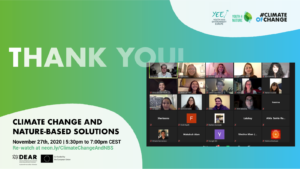 In case you weren’t able to make it, you can watch it here or read the following summary, and if you did manage to join us and want to learn more about the topic, then we have assembled some additional resources for you below!
In case you weren’t able to make it, you can watch it here or read the following summary, and if you did manage to join us and want to learn more about the topic, then we have assembled some additional resources for you below!The first speaker we heard from was Amanda Krijgsman, Junior Researcher on Nature-Based Solutions at Wageningen University & Research, part of the IPBES technical support unit on scenarios and models, and the Global Ambassador for Youth4Nature. She talked about the relationship between the climate crisis and the biodiversity crisis, and how, although ecosystems underpin almost all aspects of human development, they are being degraded faster now than ever before in human history. Amanda then gave us the recent IUCN definition of nature-based solutions (NBS) as “actions to protect, sustainably manage, and restore natural or modified ecosystems”, and illustrated the positive role that they play in mitigating both of these emergencies and in improving human well-being. She really got across how vital it is that we fully recognise how much nature provides to us, how interdependent we are with it, and thus how important it is to safeguard it.
Our second panellist was Eirini Sakellari, a member of the Youth Team of the Global Landscapes Forum and the Policy Working Group of Global Youth Biodiversity Network Europe+, as well as the co-founder of the Not Just Fashion movement in Greece.
 She explained that NBS is quickly becoming a major topic in policy discussions, but this move from a niche academic subject to a mainstream policy tool has led to a number of competing interpretations of the concept, as well as thus the risk of the greenwashing of practices by businesses or governments that are in fact actually harmful. One of the most common challenges that this implementation of NBS faces is the lack of transparent or democratised decision-making. In order to address these issues, Eirini concluded by emphasising some key considerations called for by youth, in particular that NBS must be context-specific and informed not only by science but also by indigenous people and women.
She explained that NBS is quickly becoming a major topic in policy discussions, but this move from a niche academic subject to a mainstream policy tool has led to a number of competing interpretations of the concept, as well as thus the risk of the greenwashing of practices by businesses or governments that are in fact actually harmful. One of the most common challenges that this implementation of NBS faces is the lack of transparent or democratised decision-making. In order to address these issues, Eirini concluded by emphasising some key considerations called for by youth, in particular that NBS must be context-specific and informed not only by science but also by indigenous people and women.Our final speaker was Laura Hildt, Associate Policy Officer for Biodiversity and EU Affairs at the European Environmental Bureau,
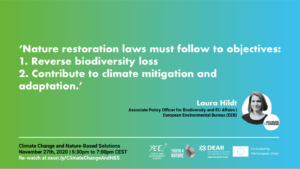 focusing in particular on the EU’s Biodiversity Strategy for 2030 and the implementation of the Nature Directives. Laura gave us great insight into what kind of policies with regard to NBS are being currently implemented or proposed, especially at an EU level. A recent EEA report declared that over 80% of habitats in Europe are in poor condition, and so thankfully the EU has committed to create a legally binding nature ‘restoration law’ in 2021 as part of its 2030 Biodiversity Strategy. Laura highlighted some important preconditions for the law, including that it be specific and urgent and not undermine or duplicate existing regulations. It should also create synergies in addressing the biodiversity and climate crises simultaneously, for example by focusing in particular on restoring and protecting areas such as peatlands, wetlands, and old-growth forests, which are all great for carbon storage.
focusing in particular on the EU’s Biodiversity Strategy for 2030 and the implementation of the Nature Directives. Laura gave us great insight into what kind of policies with regard to NBS are being currently implemented or proposed, especially at an EU level. A recent EEA report declared that over 80% of habitats in Europe are in poor condition, and so thankfully the EU has committed to create a legally binding nature ‘restoration law’ in 2021 as part of its 2030 Biodiversity Strategy. Laura highlighted some important preconditions for the law, including that it be specific and urgent and not undermine or duplicate existing regulations. It should also create synergies in addressing the biodiversity and climate crises simultaneously, for example by focusing in particular on restoring and protecting areas such as peatlands, wetlands, and old-growth forests, which are all great for carbon storage.Most of the running time of the webinar was then devoted to our superb panellists responding to each other and to questions from our audience, exploring the complexities of, and going into greater detail about, the implementation and role of NBS. Our speakers made the point that although implementing NBS ‘correctly’ is very complex, it is very important that governments do not thus seek to cut corners. Amanda mentioned how governments often have a history of ‘solving’ one issue by creating another one or simply pushing it to another country or a later date, for example by relying too heavily on biomass as a transition fuel. Laura pointed out how much the details matter, for example that improving an ecosystem at near-destruction by only a little bit may count as ‘restoration’ in name under some policies, but it does not at all count that way in spirit. Eirini described how NBS is in fact really the oldest and most natural tool that we have and that if we want to have NBS policies, not only be successful, but even adopted at all, then the buy-in and knowledge of local communities with traditional practices is so necessary.
Overall, our amazing speakers brilliantly illustrated how interrelated the climate and biodiversity crises are, and the important role that NBS can provide both in restoring ecosystems and biodiversity and also in mitigating and adapting to climate change. The challenge of doing this in a manner that is truly sustainable and also socially and economically just is an incredibly difficult one, but by remaining flexible and adaptive in our implementation of NBS, making use of local and indigenous knowledge, and taking a participatory planning approach perhaps we can avoid the even greater challenges of inaction in the face of these crises (EU Restoration Law 2021, take note!).
8 December 2020
Youth Dialogue with DG CLIMA
On December 8th, Youth and Environment Europe (YEE) organised the first Youth Dialogue with DG CLIMA to close the #ClimateOfChange project. For the better part of an hour, participants were able to question Director-General Mauro Petriccione on the EU’s climate policy and voice their ideas on what needs to change.
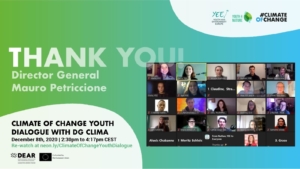
In the first part of the online event, participants debated among each other what question should be asked to the Director-General. To do so they were divided into thematic breakout rooms moderated by different members YEE’s Advocacy Members and Charlotte Billingham from the Foundation for Progressive European Studies (FEPS). Each of the three rooms reflected themes from the previous webinars in the Climate of Change series – Intergenerational justice (a thread running throughout the whole series), Climate and Nature (Building on the third webinar on nature-based solutions), and Adaptation to Climate Change (Combining elements from the webinars on climate migration and nature-based solutions).
After an introduction by Nathan Méténier, YEE’s External relations Officer, Vladislav Kaim and Nisreen Elsaim, members of the UN Secretary General’s Youth Advisory Group on Climate Change, and Venetia Galanaki, YEE Liaison Officer on Oceans and Arctic focused on the regional impacts of the EU’s climate policies. Vladislav made it clear that given the greater fossil fuel dependency of Eastern European countries, the EU needs to provide sufficient financial means to allow for a just transition in the region. Nisreen urged the DG to think about three concrete points: i.) A Life Programme for Africa, ii.) Reshape the AU-EU Summit agenda to allow for youth to interact with policymakers, and iii.) Exchange programmes for European Youth to come to Africa to see the effects of climate change on the ground. Ven raised concerns about the EU’s reliance on fossil fuels from the Arctic to assure its energy security and wanted to know how DG CLIMA will ensure that this stance does not conflict with the EU’s climate ambitions.
Mauro Petricione answered Vlad’s question by stressing the urgency to think of climate transformation as a philosophy that needs to be the baseline in everything we do. Protecting the climate and the environment is not an optional add-on that we can afford with special resources. We will only succeed in creating green jobs and living well within the planetary boundaries if we look at all investments through the lens of sustainability. In response to Nisreen’s comments, Petriccione explained that legally, funding for the LIFE programme cannot be used outside of the EU. Nonetheless, it should be possible to find alternative sources to create the incentives for a similar programme on the African continent. Referring to the point on exchange programmes between the European and African youth, Petriccione made it clear that it depends on generational change. However, he added that he has seen an evolution into that direction over the last few years. His answer with regards to the reshaping of the agenda of the AU-EU summit to allow for greater youth engagement was less positive, but he said he would try. On Venetia’s question, he was even more straightforward. He reminded the audience that even if we get to a zero-carbon economy by 2050, warming in the Arctic is going to continue beyond that year. He criticised countries’ selfish interest in the resources that are currently still inaccessible but ended on a positive note. Good signs are coming from the future Biden administration, and that could forebode well for the Arctic.
In the second round of questions,
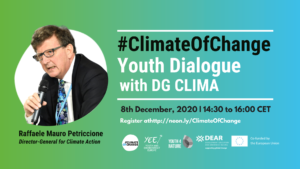 representatives from the European youth asked the DG about the possibility of allowing youth to participate in the COP26 negotiations, open negotiations at the COP26 at which the youth could participate, how links between climate action and environmental policies can be fostered to prevent them from being played out against each other, and how policy can preemptively tackle the impact of climate change on our health systems. And, of course, there was also a question on whether the Commission would withdraw the CAP. No was the short answer to that as the CAP is essential to farming in Europe despite there being things in it that are simply not good enough. And while he is aware that in the eyes of many youth climate activists the CAP should be withdrawn, he is happy that for the first time in his career in the EU institutions young people are having a closer look at it. Then in his eyes, the youth is extraordinarily powerful in reminding people that things can change.
representatives from the European youth asked the DG about the possibility of allowing youth to participate in the COP26 negotiations, open negotiations at the COP26 at which the youth could participate, how links between climate action and environmental policies can be fostered to prevent them from being played out against each other, and how policy can preemptively tackle the impact of climate change on our health systems. And, of course, there was also a question on whether the Commission would withdraw the CAP. No was the short answer to that as the CAP is essential to farming in Europe despite there being things in it that are simply not good enough. And while he is aware that in the eyes of many youth climate activists the CAP should be withdrawn, he is happy that for the first time in his career in the EU institutions young people are having a closer look at it. Then in his eyes, the youth is extraordinarily powerful in reminding people that things can change.We at Youth and Environment could not agree more with this closing remark, and are already looking forward to the next Youth Dialogue with DG CLIMA!


 YEE aims to unite environmental youth non-profit organisations in Europe in order to enhance international cooperation, increase knowledge about the climate crisis, raise awareness of environmental problems and to strengthen participation of youth in environmental decision-making.
YEE aims to unite environmental youth non-profit organisations in Europe in order to enhance international cooperation, increase knowledge about the climate crisis, raise awareness of environmental problems and to strengthen participation of youth in environmental decision-making.



